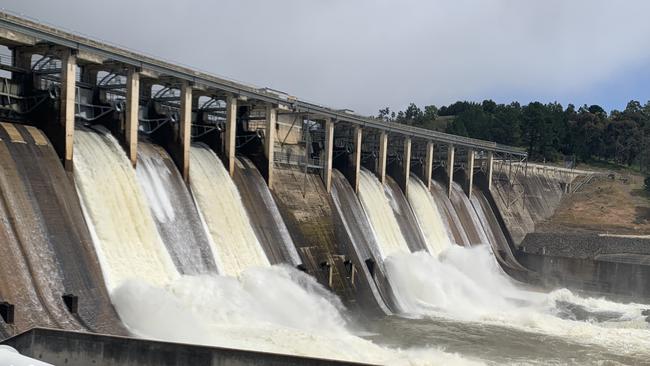Crops damaged in farm flooding across south eastern Australia
Major flooding across south eastern Australia has inundated properties and drenched crops. See the pictures.
Major flooding across south eastern Australia over the weekend has inundated properties and drenched crops.
While most grain growers in Queensland have completed harvest, some NSW growers are now facing downgraded quality in what was set to be a bumper crop.
And livestock farmers have been bracing for the cold snap, moving freshly shorn sheep into sheds and many others waiting on shearers, who have been held up by at least a fortnight by the wet weather.
In Gippsland, water was gushing out of the gates of the Lake Glenmaggie weir where it’s been raining on and off all morning, and paddocks on nearby farms are already under water. With water lapping the top of the gates of the weir, there are concerns more rain today upstream of the lake may mean more gates will need to be opened and flood farms downstream.

Primary producers took to social media to share photos and videos of flooded rivers and crop damage.
In Bellata, in northern NSW, Andrew McClenaghan shared photos of his wheat crop that has been downgraded by the soaking.
Done the obligatory drive around, no neighbours headers going so I think I’ll resume the foetal position. I guess the market for activated wheat is not that big. pic.twitter.com/8lMjB5BqGN
— Andrew McClenaghan (@AndrewMcClenag1) November 14, 2021
At Goondiwindi in southern Queensland Dave Beare said strong winds had shattered crops, knocking grains to the ground.
You’re not alone . What is worse is the amount of shattered grain on the ground from the howling winds over the last couple of days pic.twitter.com/VbOqceRMjS
— Dave Beare (@Portreath44) November 14, 2021
In NSW, Wyangala Dam dominated headlines over the weekend, as it spilt 30 gigalitres of water a day into the Lachlan River, inundating properties downstream.
Wyangala dam spilling 30 gigalitres a day. This is roaring. Major concerns for towns downstream. pic.twitter.com/4npFCBJNF5
— Xanthe Gregory (@xanthe_gregory) November 12, 2021
Downstream of Wyangala, Brendan Mansbridge at Eugowra lost a hay crop as the Lachlan River swelled and sent a paddock underwater.
Might be a bit hard to bale this hay now, watching the windrows float away #lachlanflood21pic.twitter.com/OVXnrzD6Il
— Brendan Mansbridge (@BR_Mansbridge) November 14, 2021
Waking up to waterfront views this morning, our irrigated flats now completely underwater. Equal to 2016 at present and still a bit more to come we think #lachlanflood21pic.twitter.com/birg9qESHV
— Brendan Mansbridge (@BR_Mansbridge) November 14, 2021
Downstream at Forbes the Lachlan River was running high and still rising on Sunday.
The Iron Bridge flood gauge on the Lachlan River at #Forbes is at eight metres. It’s expected to reach at least 10.55m on Tuesday morning. I’d be under water from where I’m standing! pic.twitter.com/20Mv26DUDY
— Joanna Woodburn (@JoannaWoodburn) November 14, 2021
The Bureau of Meteorology’s Jackson Browne said there was “quite a bit of rain” across much of Australia last week due to a low pressure system from Western Australia, which brought with it an “unusually moist air mass” over eastern Australia.
“This led to riverine risees and flash flooding, with moderate to major flood warnings in place for the Lachlan River and Belubula River in NSW and Macintyre and Bulloo rivers in Queensland,” Mr Browne said.
He said the amount of rainfall in the past seven days hasn’t been “particularly high” but it has been the extent of the coverage, which means water has settled into catchments, causing flooding.
Orange in NSW has recorded the highest total in NSW the past seven days with 132mm, Murrurundi measured 114mm and Crookwell108mm, while Mt Moornapa in Gippsland recorded 162mm, Mt Baw Baw 145mm and Bullengarook 82mm.
Meanwhile, Victorian Farmers Federation livestock group president Steven Harrison, from Giffard West, said a lot of producers were trying to shear at the moment, when they could get sheep dry.
However, Mr Harrison said the rain was holding up most shearers for a week or two.
The cold snap has also meant freshly shorn sheep have had to be moved to sheds or protected paddocks.
“I know one farmer stopped shearing on Friday and moved his freshly shorn sheep into the shearing shed to protect them from the cold, as welfare is most important,” he said.
Mr Harrison said many were also waiting for a break in the rain to cut and bale hay and silage.
“But we will take the rain over the dust.”
QUEENSLAND
Rivers and flood plains swelled across southern Queensland over the weekend, sending low lying properties underwater.
At Condamine, Jake Hamilton took the boat out to visit his neighbours on Saturday.
Just your average Saturday visiting the neighbours for a beer. #Balonnepic.twitter.com/e6ctCeSDDI
— Jake Hamilton (@jakeonfarm) November 13, 2021
In Dalby, Tim Morris shared this video of high flows in Myall Creek.
Not the usual flow down this creek…… #moistpic.twitter.com/OXzYZ0qPjP
— Tim Morris 🇦🇺 (@lotzhobbitfeet) November 12, 2021
VICTORIA
It comes as rain gauges across western and central Gippsland filled faster than most other Victorian regions last week, with more than 20 millimetres falling in Warragul and the Latrobe Valley between 9am and 4pm on Friday, according to the Bureau of Meteorology.
Lakes Entrance notched up 17mm, Bairnsdale 19mm and Yarram 15mm in the same seven hour time frame.
United Dairyfarmers of Victoria president Paul Mumford said the rain was moderate but persistent across much of Gippsland last week.
“This is only really the start of it (as of 3pm Friday). It’s not heavy yet but it is relentless,” Mr Mumford said.
“We’re looking at 50mm already in parts of east Gippsland and the expectation is that’s going to keep on through the rest of Friday into Saturday.
“Bairnsdale through to Yarram have really been drenched. It’s too early to tell what the impact will be but anyone with a farm close to a river or a creek or with a dam that’s already full will be concerned.”




